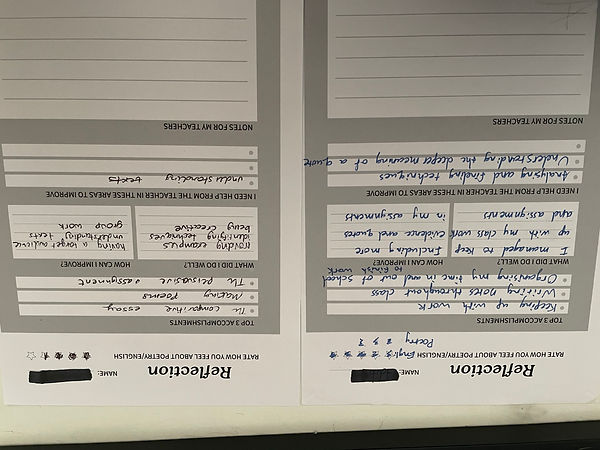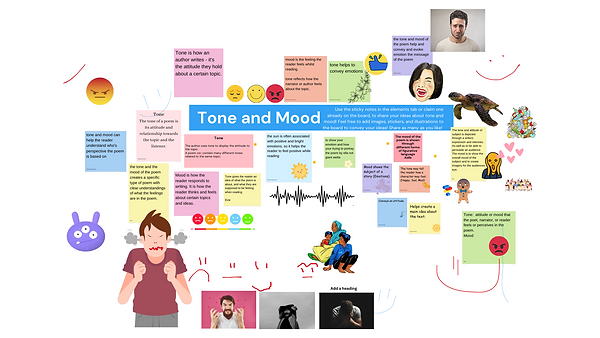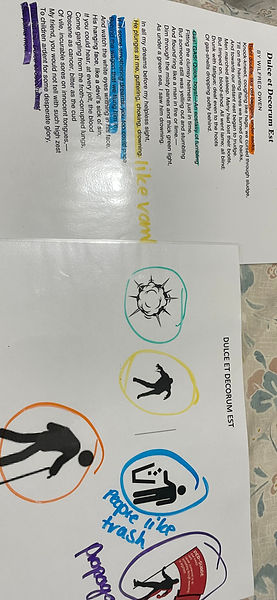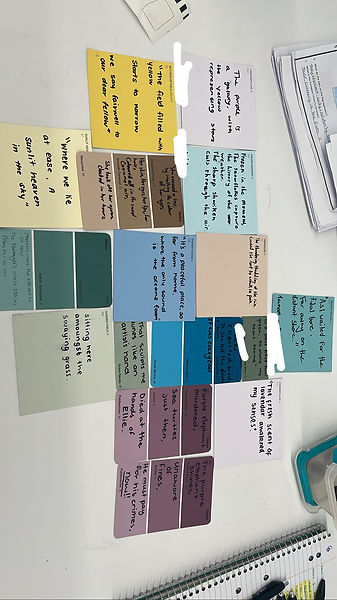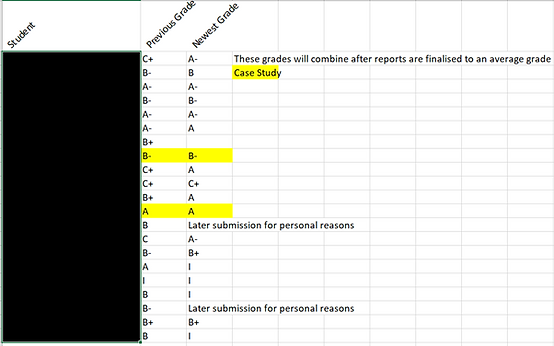Evidence Set 2: Professional Practice
Context
As educators, we are the experts in the classroom and must possess a wealth of knowledge that can be drawn upon to meet the needs of our students in the changing learning environment. I have focused on forming strong relationships to better understand how my students learn, supporting student participation, and create a safe learning environment. Understanding students, their social needs, and learning needs, is an important aspect of teaching, not only to meet the needs of students and maintain a safe and supportive environment in the classroom. Without positive relationships in the classroom, I found it harder to implement effective learning opportunities as students become disengaged. Taking part in genuine attempts to establish and improve the relationship with students, has been identified in the literature as an effective strategy for improving the academic and school-based achievements of students (Kennedy, 2021).
I have had the opportunity on a recent placement to teach across two different learning areas, spanning four year levels (year 8 through to year 11), in a catholic school. I also had the opportunity to teach in a pastoral care classroom, which had a heavy emphasis on safe and supportive classroom spaces, and community connections.
Action
Reflecting on the feedback provided to me by students, discussed in Evidence Set 1, I planned to modify my teaching practice based on the student self-assessment and as a result, I implemented lessons which had an appropriate level of cognitive challenge in a way that students would be receptive to. I made these goals available to students through SEQTA, as ‘success criteria’ for the lesson, alongside a checklist for students to complete. This also facilitated student engagement and participation as students who were absent were provided with this checklist and supporting materials, so that they were not missing content. In the classroom, goals were set by using collaborative discussion to create clear instructions and goals on the whiteboard. Students were encouraged to take pictures of the board gave them their own resources to refer back to.
Figure 2: Whiteboard used to show steps of analysing poetry. Students identified goals under each example of what they wanted to understand. FA 3.1, 3.4, 3.5, 4.1, 4.2
I also supported this by ensuring I emailed each student who was absent, to ensure they were clear on the expectation of the lesson. Parents also had access to this information and are able to review learning materials and are encouraged to reach out to staff with any concerns or adjustments needed.
Figure 3: Goals as Success Criteria on SEQTA. FA 3.1, 3.7, 4.1,
Figure 4: Email to absent student. FA 3.5, 4.1
Due to the learning needs of my students, I implemented various different teaching methods throughout my 6 week unit plan. I used methods such as literature circles, in conjunction with tiered differentiation to provide students with appropriate challenge, from developing skills, to enhancing their learning. Students were provided with a choice of topic in this activity in an effort to support student participation through pedagogy and teaching method choice. I also implemented the use of Canva whiteboards in my classroom, to support students who found it hard to put their learning into words. This use of ICT resources was to support my implementation of student-centred pedagogy, which allows students to learn from one another, while I act as a feedback provider, after initial content delivery.
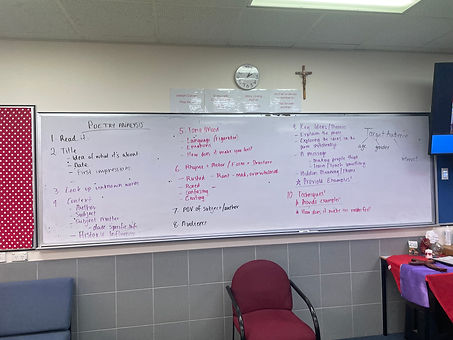
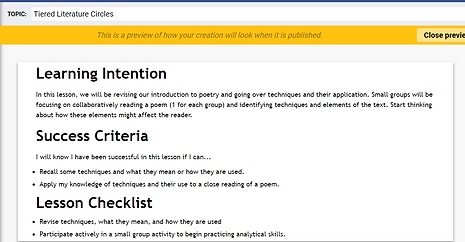
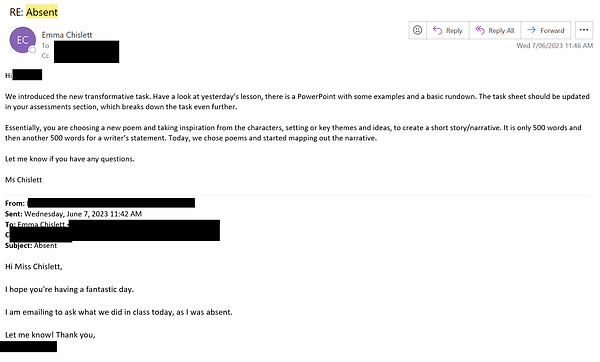
6 week unit plan.
I implored to focus on relationship building throughout my time at my previous placement. In an effort to partake in deliberate and genuine attempts to build relationships, I implemented evidence based strategies such as active supervision and the 5-to-1 praise rule (Gage, 2020), (Downs, 2019) which focuses on actively moving around the classroom, and actively praising students, usually in a 5-to-1 ratio, 5 compliments and 1 constructive criticism.
Figure 5: Mentor feedback about my active supervision of the classroom, and use of praise. – FA 3.5, 4.1
I maintained student relationships by constantly checking in with students regularly and verbally during classroom activities, keeping an open communication about expectations, and allowing for flexible classroom arrangements, supported by the facilities at the school. Halfway through the unit, I asked students to complete an evaluation of teaching as well as reflect on their own learning needs in order to evaluate my own teaching and modify my plan to improve student learning. Students identified areas in which they needed teacher support going forward, and I used this to plan and implement new learning activities in the coming weeks.
Figure 6: Student Evaluation of Teaching and Learning FA 3.6, 4.1, 5.1, 5.4
Students also identified the need for less distractions in the classroom. As a result, I focused on the organisational structures in place to manage challenging behaviour. I used techniques such as proximity and non-verbal communication, before working through the levels of intervention set out by the school. This began with moving seats or leaving the classroom to compose themselves, and then moved on to a restorative conversation and intervention from leadership. I effectively used level 1 of the intervention system and was able to rarely remove students from the learning environment.
Figure 7: Feedback from mentor about student behaviour management FA: 4.3, 4.4
During the unit, students were working towards their summative assessment which fell under ‘Assessment Type 1: Responding to Texts’ in the Stage 1 SACE curriculum. Due to the requirements of the curriculum, I was able to plan and implement time to complete the drafting process with each student. I reflected on the relationships I had built with students to determine that written, verbal and class feedback were appropriate for the class. Studies have shown that the type of feedback students are most responsive to is reliant on the type of learner the student perceives them to be (Rowe, 2008), so I implored to include an element of visual feedback. I provided comments and tracked changes on drafts as well as providing a visual map of general class feedback. I used the SACE performance standards to make equitable judgements on each assignment.
Figure 8: Example of feedback on a student draft based on the performance standards of the task sheet. FA: 5.1, 5.2, 5.3
Results:
Throughout the unit, students were extremely engaged in the SEQTA page, as it provided them with an opportunity to work at their own pace in the classroom, where appropriate. The use of success criteria provided students who had significant issues in the classroom, a baseline to achieve. These students often took advantage of flexible learning areas outside of the classroom, so providing these details on SEQTA was imperative. The student-centred pedagogy I applied to my teaching worked well in the senior classroom environment. Using the whiteboard and other ICT tools allowed for students to learn from one another, while I acted as a feedback-provider, someone to clarify questions and I was also able to closely monitor ICT use to keep students safe. One activity that students responded well to be the use of Canva whiteboards. Similar to a mood board we would draw in books or on a whiteboard in class, Canva allows students to express their understanding using words, pictures, songs, and drawings. Students remained engaged throughout the activity and reflected on understanding the concepts of tone and mood more after the activity, as they were able to use visual elements to explain the terms. This activity also promoted the engagement of students who are not social due to trauma and other difficulties. As a part of their PPLs, teachers are asked not to force social interaction, so I used this way to allow them to still contribute to classroom conversations.
Figure 9: Student work on tone and mood FA: 3.4, 3.5, 4.1, 4.5
Another activity that worked well and engaged student was the tiered differentiation with literature circles. I used the concepts of tiered differentiation which focuses on the cognitive challenge a task brings being appropriate for students by grouping them together to work. This is employed in a way that is sensitive to the perceptions of these groups. By asking students to choose which group they were in, after a discussion about the challenges of each group, students found themselves in appropriate groups and faced with applying and developing skills or enhancing their skills. I focused my attention on the group with the most learning needs, but also moved around the classroom and gave students guiding questions to offer more opportunities for understanding.
Figure 10: Student work from tiered literature circle task FA: 1.2, 3.1, 3.2, 3.3, 4.1
With one group of students, the higher achievers were disengaged as a result of the challenge. I reflected on this lesson and realised that for activities like this in the future, a seating plan would be beneficial (as discussed in evidence set 1), as the disengaged students seemed to be influenced by friends around them, while being completely capable of using the skills of the task. The other groups of students maintained engagement and were able to collaboratively share their analysis of the poem as well as the answer to their decoding activity, pictured in figure 10. In figure 11, you will see comments from my mentor about the engagement of students.
Figure 11: Feedback from Observer about student engagement
To battle disengagement, I also asked students to use one single lesson a week to focus on implementing the techniques and devices in the content. Students reflected that this was a good way to learn about techniques as they understood them more. There was a range of different prompts supplied to students including paint chips (as seen in Figure 12), describing items around the school, and focusing on specific techniques. This encouraged engagement and learning through more hands on and practical application of the content, which reflected the learning needs students identified at the start of the unit.
Figure 12: Student work based on paint colours. FA 3.1, 3.2, 3.3, 4.1, 4.2
Through my implementation of the levels of intervention, students were able to contribute more to class and had more opportunities to participate in effective classroom communication as the distractions were now at a minimum. This was important as the unit ended as the class was working on summative assessments, and minimal distractions during the drafting process allowed students to ask questions and contribute to conversations without losing a train of thought or being interrupted.
Students engaged in the drafting process well and applied feedback from their drafts to enhance their work. The written feedback I provided to each student was also provided to the class in a more general format, and the class visually mapped out areas for improvement on the board. Students used this as a checklist to improve their drafts. In the unit, one lesson was planned to go over the SACE rubric and the drafting comments. Most students were able to improve their individual assignment grade and maintained or improved their cumulative grade in the class. I taught many students who had SACE accommodations to remove a task as well as a few students requiring extensions for personal reasons. Due to this, all feedback was provided via SEQTA for the later completion of the task. Results and comments are now provided to students via SEQTA to communicate achievement. I ensured each comment provided one area of improvement as well as one comment on their personal achievement, as a few of my classes struggled with self-confidence.
Figure 13: Student grades from the good copies FA 5.2,5.3, 5.4 Figure 14: Feedback to student focusing on achievement, available to parent. FA 5.2, 5.3, 5.4, 5.5, 7.3
Evaluation
I have researched professional development opportunities which I can undertake to better understand student disengagement as well as social influences on learning. I feel as though if I understand this area better, I will be able to combat it more effectively in the classroom. This experience was my first experience in an English classroom, and it was a senior stage 1 class. I believe I was able to implement my content knowledge in a mature way, which gave students an opportunity to apply the content and their own understanding to a variety of learning activities. The use of different learning activities which broke up the new and revised content provided opportunities to build rapport with students and manage welfare and academic issues.
My goal to build better relationships with the students was achievable, and my use of evidence-informed practices made this a seamless effort as it blended well with the pedagogies I aim to implement in my teaching. Students provided me with positive feedback at the end of my placement which commented on our relationships in the classroom, and my mentor reflected that I knew the students well and maintained these relationships respectively.
The results of the students in their poetry analysis summative task were reflective of effective learning activities and a safe and inclusive learning environment. In the future, I would ensure I am consistent with my content delivery, including where I stand in the classroom, as I realised some students rely on visual resources as well as seeing me talk through the content.
Standards
3.1 Establish challenging learning goals.
Used student feedback to establish learning goals, as well as evaluating IEPs/PPLs. Focused on enhancing high achievers.
Figures 2 and 3: Work was clearly mapped out on the board or on SEQTA to provide learning goals.
Figures 10 and 12: Results of clear learning goals
3.2 Plan, structure, and sequence learning programs
I planned and implemented a range of activities into the learning program, as well as planning the 6 week unit by myself.
Figure 10 and 12: Results of different activities in the learning program.
3.3 Use teaching strategies
Implemented more visual teaching strategies such as dual coding and creative writing work to break up content and give students more ways to explore techniques.
Figure 10 and 12: Results of different activities in the learning program.
3.4 Select and use resources.
Used a range of resources including YouTube videos, ICT tools and classroom discussion using school resources.
Figure 2: Use of whiteboard to consolidate learning.
Figure 9: Use of ICT to facilitate group discussion and student-centred pedagogy.
3.5 Use effective classroom communication
Used a range of verbal and non-verbal ways of communication.
Figure 2: Use of whiteboard to consolidate learning.
Figure 4: Email to student who was absent to ensure they did not fall behind.
Figure 5: Mentor feedback about communication.
Figure 9: Use of ICT to facilitate group discussion and student-centred pedagogy.
3.6 Evaluate and improve teaching programs.
Figure 6: Performed a student evaluation of teaching to ensure student voice was heard in terms of how the teaching program could be improved.
3.7 Engage parents / carers in the educative process.
Figure 3: Ensured the learning program on SEQTA was involved and included each learning activity in a capacity that was simple to understand and implement at home if necessary.
4.1 Support student participation
Figures 2-6: Implemented a range of learning activities to support student participation.
Figure 9: Use of ICT resources to ensure each student had an opportunity to have an input.
Figure 10: Use of tiered literature circles enabled students to all be challenged without making it obvious that students were separated into groups.
Figure 12: Use of visual prompt for creative writing.
4.2 Manage classroom activities.
Figure 2: Clear instructions on the board to facilitate learning activity.
Figure 12: Use of visual prompt for creative writing.
4.3 Manage challenging behaviour.
Figure 7: Mentor feedback which details the use of levels of intervention to combat challenging behaviour.
4.4 Maintain student safety.
Figure 7: Mentor feedback which details the use of levels of intervention to combat challenging behaviour.
4.5 Use ICT safely, responsibly, and ethically
Figure 9: Use of ICT that is easily monitored by staff/me.
5.1 Assess student learning.
Figure 6: Use of student evaluation of teaching to begin assessment on what students are learning in a formative manner.
Figure 8: Feedback provided in a formative draft. Students had the opportunity to use the comment to improve their work.
5.2 Provide feedback to students on their learning.
Figure 8: Provided feedback to students on their formative draft.
Figure 13 and 14: Results from the good copies graphed, and good copy comments on work. This emphasised praise as well as room for improvement.
5.3 Make consistent and comparable judgements.
Figure 8: Provided feedback to students on their formative draft.
Figure 13 and 14: Results from the good copies graphed, and good copy comments on work. This emphasised praise as well as room for improvement.
This feedback was given based on the SACE rubric/performance standards.
5.4 Interpret student data.
Figure 6: Use of student evaluation of teaching to begin assessment on what students are learning in a formative manner. Feedback used to evaluate teaching program and adapt to better suit student as needed.
Figure 13 and 14: Results from the good copies graphed, and good copy comments on work. This emphasised praise as well as room for improvement.
5.5 Report on student achievement
Figure 14: Provided good comments on assessments submitted. These comments were available to parents and focused on the achievement of the child, with some suggestions on how to improve.
References
Downs, K. R., Caldarella, P., Larsen, R. A. A., Charlton, C. T., Wills, H. P., Kamps, D. M., & Wehby, J. H. (2019). Teacher Praise and Reprimands: The Differential Response of Students at Risk of Emotional and Behavioral Disorders. The Journal of Positive Behavior Interventions., 21(3), 135–147. https://doi.org/10.1177/1098300718800824
A., Haydon, T., MacSuga-Gage, A. S., Flowers, E., & Erdy, L. (2020). An Evidence-Based Review and Meta-Analysis of Active Supervision. Behavioral Disorders : Journal of the Council for Children with Behavioral Disorders., 45(2), 117–128. https://doi.org/10.1177/0198742919851021
Kennedy, A. M., & Haydon, T. (2021). Forming and Sustaining High-Quality Student–Teacher Relationships to Reduce Minor Behavioral Incidents. Intervention in School and Clinic, 56(3), 141–147. https://doi.org/10.1177/1053451220942197
Rowe, A. (2008). Student perceptions and preferences for feedback. Asian Social Science., 4(3), 1–11

